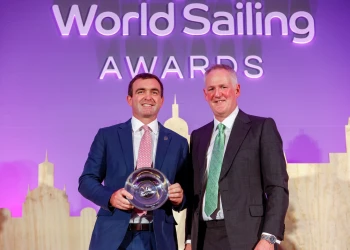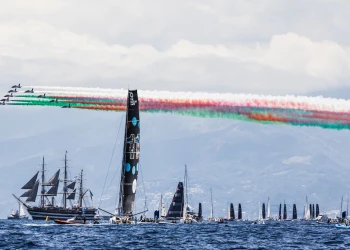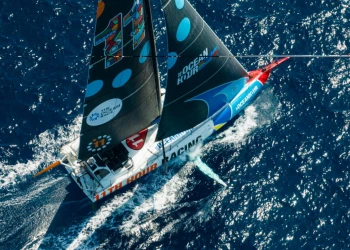
© Amory Ross / / 11th Hour Racing / The Ocean Race
Another shot of resilience for 11th Hour Racing Team
After 16 days at sea, we're approaching the halfway point of Leg 3 of The Ocean Race - the world's longest and toughest sporting event. The only US entry, 11th Hour Racing Team, is holding its own against the rest of the fleet as they pass around 400 nautical miles to the south of New Zealand. Yes, they may well have completed more than 5,000 nautical miles through the treacherous Southern Ocean since departing Cape Town, but there's still the best part of 7,000 nautical miles to go before they reach the haven of Itajaí in Brazil.
With the whole of the Pacific Ocean to the north of them, it's still a long, long way before Skipper Charlie Enright (USA) and his international crew reach Cape Horn, the most iconic landmark on this 37,500 nautical mile circumnavigation of the planet.
If the previous two weeks were a catalog of technical setbacks and challenges, there has been no let-up for week three. The team put the pedal to the metal onboard the state-of-the-art 60-foot IMOCA race boat, Mālama, as they pushed for the best points possible at the scoring gate, which ran in a north-south axis around the longitude of Tasmania.
Having got through the scoring gate in third place, netting them three points, the team deliberately slowed down the boat to give all the equipment a thorough inspection before winding Mālama back up to race pace again. While most of the gear got a clean bill of health, the big headache for week three is how to solve a one-meter rip in the carbon-fiber mainsail.
Depending on the wind and wave conditions, the crew onboard the IMOCA vary the mainsail area from 100 percent (no reefs) to either one or two reefs to reduce the sail area when the conditions get more gnarly. The team aren't quite sure what caused the tear, and the analysis will come later. Jack Bouttell (AUS/GBR) explained: "The front structural part of reef 1 is ripped off completely, so we dropped to reef 2. We can't use the full main or the first reef because of the rip."
Enright made no bones about the fact that this is a serious setback for the team. "The mainsail problems are hampering our ability to compete at 100 percent, there's no other way of looking at it. But I guess in some ways, knowing that [about the mainsail] has allowed us to focus a little bit more on yacht preservation and the journey, and an inability to push ourselves the way that we want to has put us in a more reflective state."
In other words, be grateful. Through this war of attrition, which Enright predicted more than three weeks ago, they are still rolling along at a pretty impressive pace. After setting a new 24-hour distance record the previous week (544.63 nautical miles), the dash towards the scoring gate in ideal conditions saw 11th Hour Racing Team push the bar up to a whopping 586 nautical miles, only to be narrowly beaten by Holcim-PRB just hours later, who clocked 595.26 nautical miles
Enright has been greatly encouraged to see how competitive Mālama has proven up in wind and wave states where the boat should feel compromised. "The boat was originally designed for a different racecourse when we thought the route would take us up to China, and also, due to the pandemic the race was delayed by a year. This has given time for some of the other teams to gain experience with developing the next generation of foils. Our best conditions are more likely to come later on in the race. But we've seen that when we're not dealing with breakages, we're exceptionally competitive, and that's really encouraging for the rest of the race. There are times when we've dropped some serious miles on the other boats, but we've also shown that when we can push, we are able to put down some serious miles too."
With just over 100 nautical miles separating the fleet from front to back, there is all to play for on this, the longest-ever leg in the 50-year history of the race. It's not just Mālama which is having to find innovative solutions to some difficult problems, it's all the boats, and that's an inherent part of the challenge of offshore racing.
11th Hour Racing Team are going to have to draw on all their inventiveness to solve the mainsail problem. "The sails are so much tougher than they used to be, and even just 10 years ago the sails would have weighed about three times as much," said Enright. "But when we have a breakage in a structural area of the sail, it's not a matter of sewing it back together again, it's more like a boatbuilding kind of operation."
The next high-pressure system could be an opportunity not only for strategic gains on their rivals, but also for lighter winds and a chance to repair the mainsail. After the initial shock of the breakage, Enright says the team's resilience has kicked in once again and expects they will need to call on their mental reserves many more times between now and Itajaí. "The team has regrouped, we've turned the page, and adjusted our expectations based on the state of our boat.
"Points aren't awarded for another 20 days, so we chip away at our work list and look for the opportunities, particularly with the high-pressure system on the horizon. Despite the trials and tribulations of the last few weeks everyone's pragmatic and optimistic about the situation. We're making the best of what we've got and keep on moving forward."
Leg 3 current positions as of Wednesday, March 15, 2023 1700 UTC
DTL=distance to leader
Holcim-PRB
Team Malizia - DTL 17.6nm
Biotherm - DTL 90.2nm
11th Hour Racing Team - DTL 106.8nm
Guyot environnement - Team Europe - suspended racing
11th Hour Racing Team Crew for Leg 3 of The Ocean Race 2022-23:
Charlie Enright (USA) - Skipper
Simon Fisher (GBR) - Navigator
Jack Bouttell (AUS/GBR) - Trimmer
Justine Mettraux (SUI) - Trimmer
Amory Ross (USA) - Media Crew Member
Overall Leaderboard:
5 points = first; 4 points = second etc.
Team Holcim - PRB - 15 points (5+5+5)
11th Hour Racing Team - 10 points (4+3+3)
Team Malizia - 9 points (3+2+4)
Biotherm Racing - 8 points (2+4+2)
GUYOT environnement - Team Europe - 2 points (1+1)
The Ocean Race 2022-23 Route:
Leg 1: Alicante, Spain to Mindelo, Cabo Verde
Leg 2: Cabo Verde to Cape Town, South Africa
Leg 3: Cape Town, South Africa to Itajaí, Brazil
Leg 4: Itajaí, Brazil, to Newport, Rhode Island
Leg 5: Newport, Rhode Island to Aarhus, Denmark
Leg 6: Aarhus, Denmark to The Hague, The Netherlands (with a flyby past Kiel, Germany)
Leg 7: The Hague, The Netherlands to Genoa, Italy





